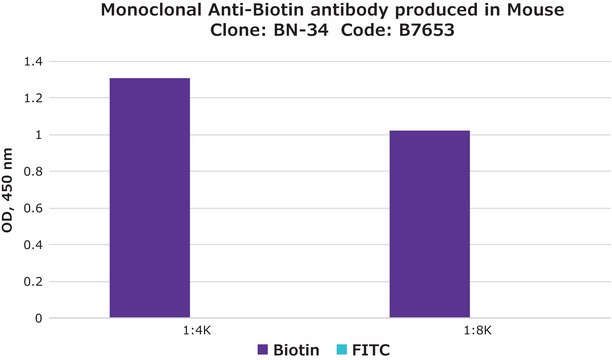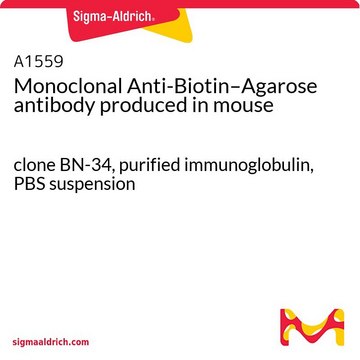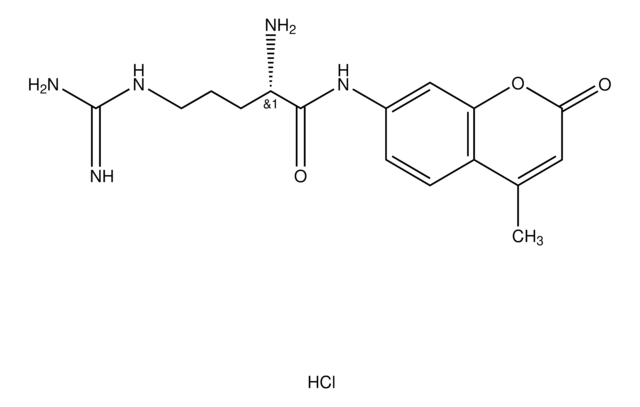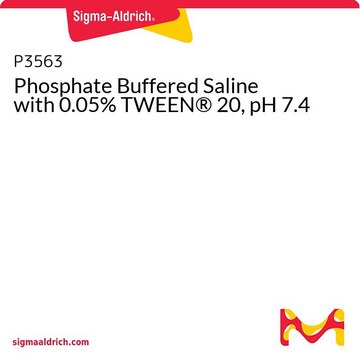A4541
Anti-Biotin−Peroxidase antibody produced in goat
affinity isolated antibody, buffered aqueous solution
Synonym(s):
Anti-Biotin, Anti Biotin Hrp
Sign Into View Organizational & Contract Pricing
Select a Size
All Photos(1)
Select a Size
Change View
About This Item
UNSPSC Code:
12352203
NACRES:
NA.46
Recommended Products
biological source
goat
Quality Level
conjugate
peroxidase conjugate
antibody form
affinity isolated antibody
antibody product type
primary antibodies
clone
polyclonal
form
buffered aqueous solution
technique(s)
direct ELISA: 1:2,000
shipped in
dry ice
storage temp.
−20°C
Looking for similar products? Visit Product Comparison Guide
General description
Biotin is an essential vitamin required for cells in living organisms and in cultures. The high binding affinity of biotin to egg white avidin or bacteria-derived streptavidin has been used to design immunoassays for detecting antigen-antibody interactions. Goat anti-biotin-peroxidase antibody can be used in many applications where biotin may be introduced as target label.
Specificity and reactivity are determined by Ouchterlony Double Diffusion and immunoelectrophoresis versus the biotin-carrier protein complex. No reactivity is observed versus the carrier protein.
Immunogen
Biotin-KLH conjugate
Application
Biotin-labeled proteins in U937 and BHK cell lysates were analyzed by western blot using HRP-conjugated goat anti-biotin.
Goat anti-biotin-peroxidase antibody can be used for direct ELISA assays at a dilution of 1:2,000.
In some applications, localization of biotinylated probes with avidin produces high background levels. Anti-biotin reagents may be substituted for avidin to decrease non-specific binding.
May be substituted for avidin to decrease non-specific binding.
Physical form
Solution in 0.01 M phosphate buffered saline, pH 7.4, containing 1% bovine serum albumin with preservative.
Preparation Note
Prepared by the periodate method described by Wilson, M.B., and Nakane, P.K., in "Immunofluorescence and Related Staining Techniques," Elsevier/North Holland Biomedical Press, Amsterdam, p215 (1978).
Disclaimer
Unless otherwise stated in our catalog or other company documentation accompanying the product(s), our products are intended for research use only and are not to be used for any other purpose, which includes but is not limited to, unauthorized commercial uses, in vitro diagnostic uses, ex vivo or in vivo therapeutic uses or any type of consumption or application to humans or animals.
Not finding the right product?
Try our Product Selector Tool.
signalword
Warning
hcodes
Hazard Classifications
Aquatic Chronic 2 - Eye Irrit. 2 - Skin Irrit. 2 - Skin Sens. 1
Storage Class
12 - Non Combustible Liquids
wgk_germany
WGK 3
flash_point_f
Not applicable
flash_point_c
Not applicable
Choose from one of the most recent versions:
Already Own This Product?
Find documentation for the products that you have recently purchased in the Document Library.
Our team of scientists has experience in all areas of research including Life Science, Material Science, Chemical Synthesis, Chromatography, Analytical and many others.
Contact Technical Service










